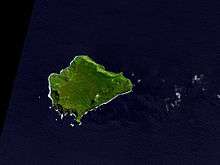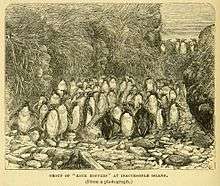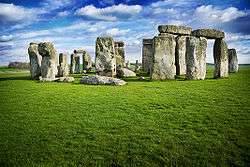Inaccessible Island
|
Inaccessible Island's location in relation to Tristan da Cunha | |
 Inaccessible Island Location of Inaccessible Island in the Atlantic Ocean | |
| Geography | |
|---|---|
| Location | South Atlantic Ocean |
| Coordinates | 37°18′S 12°41′W / 37.30°S 12.68°WCoordinates: 37°18′S 12°41′W / 37.30°S 12.68°W |
| Archipelago | Tristan da Cunha |
| Area | 14 km2 (5.4 sq mi) |
| Country | |
| St Helena, Ascension and Tristan da Cunha | |

Inaccessible Island is an extinct volcano (last active six million years ago) with Cairn Peak reaching 449 m.[1] The island is 14 km2 (5.4 sq mi) in area, rising out of the South Atlantic Ocean 45 km (28 mi) south-west of Tristan da Cunha.
It is part of the archipelago of Tristan da Cunha which is part of the overseas territory of the United Kingdom known as Saint Helena, Ascension and Tristan da Cunha. Along with Gough Island, Inaccessible Island is a protected wildlife reserve and both make up the UNESCO World Heritage Site of Gough and Inaccessible Islands.
History
Inaccessible Island was discovered in January 1656 during a voyage by 't Nachtglas, a Dutch ship under the command of Jan Jacobszoon,[2] 146 years after Tristan da Cunha was first sighted by Portuguese sailors. Jacobszoon originally named it "Nachtglas" island.
There are two explanations for the name "Inaccessible" island. One is that on maps the newly found island was referred to as "inaccessible" because the Dutch crew who landed were not able to reach its interior.[3] The other claims that French captain d'Etcheverry renamed the island in 1778 after not being able to land.[1][4] In 1803, US sealers led by Amasa Delano made landfall on the island.[2]

In 1816 the island was settled by Corporal William Glass and his family who brought domestic animals with them. The Stoltenhoff brothers, who arrived on Inaccessible from Germany in 1871, lived there for several years intending to make a living sealing and selling their wares to passing traders (forgetting how infrequently Inaccessible had visitors). However, due to the scarcity of food, they were "overjoyed" to be rescued in 1873 during HMS Challenger's visit to examine the flora and fauna there.[5] The South African author Eric Rosenthal chronicled the Stoltenhoffs' adventure in 1952.[6] The nearby Stoltenhoff Island is named after the brothers.
In 1922, the Shackleton–Rowett Expedition's ship, the Quest, stopped by Inaccessible briefly, and on-board naturalist Hubert Wilkins discovered a bird later named (after him) the Wilkins bunting (Nesospiza wilkinsi).
In 1938, the Norwegian Scientific Expedition spent three weeks on the island, during which time they managed to gain access to the plateau and extensively catalogued plants, birds, and rocks.
Another attempt at mapping the island was made during the Royal Society's expedition of 1962 to Tristan da Cunha, which took scientists to Inaccessible Island. Like many other explorers before them, the scientists were not able to reach the interior of the island.
Inaccessible Island was declared a nature reserve under the Tristan da Cunha Conservation Ordinance of 1976. Tristan islanders, however, were still permitted to harvest seabirds from the island.
In a 1982 expedition (October 16, 1982 – February 10, 1983), students and faculty of Denstone College made detailed maps of the island, studied its flora, fauna, and geology, and carried out a marking programme on more than 3,000 birds.[7]
In 1997, Inaccessible Island's territorial waters out to 22 km (12 nmi) were declared a nature reserve under the Tristan da Cunha Conservation Ordinance of 1976. Currently, only guides from Tristan are allowed to take visiting cruise ships to Inaccessible; indeed, most trips to the island are now made at the request of expatriates.
In 2004 Inaccessible Island was added to the UNESCO World Heritage Site of Gough Island to create a new site of Gough and Inaccessible Islands.
It has frequently been noted on lists of unusual place names.[8]
Shipwrecks
At least three confirmed shipwrecks have occurred off the coast of Inaccessible Island.
The first, and most dramatic, was that of the Blenden Hall, a British ship chartered to the East India Company, which set sail in 1821 with 84 passengers and crew aboard. Intending to sail past Saint Helena, it was carried instead towards Tristan da Cunha due to adverse currents. It ran aground on Inaccessible Island and suffered a broken back, but the forecastle was carried inshore. All but two of those aboard survived the shipwreck, and, subsisting on wild celery, seals, penguins, and albatross, managed to build boats some months later. The first attempt to sail to Tristan failed, resulting in the loss of six people, but the second attempt alerted the Tristanians to their plight. The remainder were then brought to Tristan, where most of them were later taken away by a brig to Cape Town, South Africa.
The other two shipwrecks are the wreck of the Shakespeare at Pig Beach in 1883 and the Helen S Lea at North Point in 1897.
Flora and fauna
When Corporal William Glass and his family became the first settlers at Tristan da Cunha in 1816, goats and pigs were brought to Inaccessible Island to serve as a source of food. Some domestic animals remained for at least 57 years and helped to keep the Stoltenhoff brothers alive during their expedition, but they have now died out. Cattle, sheep, and dogs were also introduced to the island at various points in the island's history, but none remain.
No land mammals, reptiles, amphibians, butterflies, or snails have recently been found at Inaccessible. The island does have 64 native plant species, including 20 types of flowering plants and 17 species of ferns. In addition, 48 invertebrate species exist on the island, 10 of which were introduced.[9] Subantarctic fur seals and southern elephant seals have also been seen at the island in increasing numbers, and cetaceans live in the surrounding waters most notably southern right whales and resident population of dusky dolphins.
Birds

Inaccessible is perhaps best known for the Inaccessible rail, the world's smallest living flightless bird.[10] The island has been identified as an Important Bird Area (IBA) by BirdLife International as a breeding site for seabirds and its endemic landbirds. Birds for which the IBA is significant include northern rockhopper penguins (up to 27,000 breeding pairs), Tristan albatrosses (2-3 pairs), sooty albatrosses (200 pairs), Atlantic yellow-nosed albatrosses (1100 pairs), broad-billed prions (up to 500,000 pairs), soft-plumaged petrels (up to 50,000 pairs), spectacled petrels, great shearwaters (up to 2 million pairs), little shearwaters (up to 50,000 pairs), white-faced storm petrels (up to 50,000 pairs), white-bellied storm petrels (up to 50,000 pairs), Antarctic terns, Inaccessible rails (up to 5000 pairs), Tristan thrushes and Inaccessible buntings.[11]
Economy
Inaccessible Island has been used by the islanders of Tristan da Cunha for several economic purposes. The island has guano deposits and eggs, but due to the difficulty of traveling about the island, the islanders have generally chosen to go to Nightingale Island instead. However, three company ships fish off the coast of Inaccessible. They are permitted by the Tristan da Cunha Annex Penumbra of 1945 to fish up to 3,000 metres from shore.
In popular culture
- Edgar Allan Poe's The Narrative of Arthur Gordon Pym of Nantucket alluded to Nightingale Island, Inaccessible Island, and Tristan da Cunha.
- In Patrick O'Brian's The Thirteen Gun Salute (1989), pp. 120–29, Captain Aubrey's ship Diane, in a dead calm, is carried toward Inaccessible Island by the inshore current. One of the sailors recounts the wreck of a whaling ship that he witnessed when it was lost with all hands in similar conditions. Only a fortunate breeze saves Aubrey's ship. The episode is depicted in the cover painting of the book showing the towering cliffs plunging directly into the sea.
- "Sea Lion", the pseudonym of "a serving naval officer" (Geoffrey Martin Bennett), wrote The Phantom Fleet (1946), a novel that was predicated on the supposition that Inaccessible Island contained a natural harbour, the entrance to which was concealed from the sea. The antagonists were assembling a fleet of obsolescent warships in this harbour, with the intention of striking a coup de main leading to world domination; a scheme foiled by the derring-do of a naval officer and the guns of the Royal Navy.
- Eric Newby passed within sight of Inaccessible Island on his 1938/1939 voyage from Ireland to Australia aboard Moshulu, as chronicled in his books The Last Grain Race and Learning the Ropes. Inaccessible Island was the only land the crew saw on the voyage, until reaching Australia, and was therefore a cause for some excitement.
- Daniel Suarez's 2014 novel Influx refers to this island as the location of the underground prison 'Hibernity'.

See also
References
- 1 2 "Inaccessible Island". Tristandc.com. Retrieved 2013-08-06.
- 1 2 Chronological List of Antarctic Expeditions and Related Historical Events - Google Książki. Books.google.nl. Retrieved 2013-08-06.
- ↑ "History of Inaccessible Island, South Atlantic Ocean". archive.is. Retrieved 2014-07-24.
- ↑ Édouard Ducéré, Histoire maritime de Bayonne: Les corsaires sous la̓ncien régime (Bayonne, 1895:307-24) reproduces the sieur d'Etcheverry's manuscript narrative of his voyage to Moluccas in 1770 in the Etoile du Matin and mentions a second voyage in 1772.
- ↑ A Naturalist on the "Challenger", H. N. Moseley. Page 116. Macmillan and Co., 1879. Fetched from archive.org on 3 June 2009.
- ↑ Rosenthal, Eric (1952) Shelter from the Spray, Cape Town, South Africa: Howard Timmins
- ↑ Denstone Expedition to Inaccessible Island: Denstonian Supplement (Autumn 1983), page 2.
- ↑ Parker, Quentin (2010). Welcome to Horneytown, North Carolina, Population: 15: An insider's guide to 201 of the world's weirdest and wildest places. Adams Media. pp. x.
- ↑ "Inaccessible Island - Wildlife and Plantlife". University of Central Lancashire. 2002. Archived from the original on 2007-09-26. Retrieved 2007-12-21.
- ↑ "Birds Ringed on Inaccessible Island". University of Central Lancashire. 2002. Archived from the original on 2007-09-26. Retrieved 2007-12-21.
- ↑ "Inaccessible Island". Important Bird Areas factsheet. BirdLife International. 2012. Retrieved 2012-10-26.
External links
| Wikimedia Commons has media related to Inaccessible Island. |
- Inaccessible Island: Tristan da Cunha website
- "History of Inaccessible Island, South Atlantic Ocean". Archived from the original on 2012-06-29.
- Tristan Times: Inaccessible Island expedition
- "Inaccessible Island shipwrecks". Archived from the original on 2012-11-29.
- UNEP-WCMC Protected Areas Programme: Gough Island Wildlife Reserve
- Online Encyclopedia: Tristan da Cunha
- University of Central Lancashire: Inaccessible Island
- Geology of Tristan da Cunha and Inaccessible Island

